
1 The power plant in Anina, Romania, known as the Anina Thermal Power Plant (Termocentrala Anina), has its roots in the industrial expansion of the early 20th century, closely tied to the development of coal mining in the Banat region. Anina was a significant mining center due to its rich coal deposits, and the construction of the power plant was intended to capitalize on this local resource to generate electricity. Built in stages beginning in the 1950s, during Romania’s communist industrialization push, the plant used lignite coal extracted from nearby mines to produce energy for both local industry and the national grid. It became a symbol of the city’s economic importance and a key employer in the area.
However, the fall of communism in 1989 marked the beginning of the plant’s decline. The aging infrastructure, environmental concerns, and decreasing efficiency of coal-based energy led to its gradual decommissioning. As Romania began transitioning toward more sustainable energy sources and restructuring its industrial sector, Anina’s coal mines closed, and the power plant followed suit in the early 2000s. Today, the ruins of the Anina power plant and its iconic chimney stand as remnants of the town’s industrial past—a poignant reminder of a once-thriving energy hub that played a critical role in the region’s development.
However, the fall of communism in 1989 marked the beginning of the plant’s decline. The aging infrastructure, environmental concerns, and decreasing efficiency of coal-based energy led to its gradual decommissioning. As Romania began transitioning toward more sustainable energy sources and restructuring its industrial sector, Anina’s coal mines closed, and the power plant followed suit in the early 2000s. Today, the ruins of the Anina power plant and its iconic chimney stand as remnants of the town’s industrial past—a poignant reminder of a once-thriving energy hub that played a critical role in the region’s development.

2 The power plant in Anina, Romania, known as the Anina Thermal Power Plant (Termocentrala Anina), has its roots in the industrial expansion of the early 20th century, closely tied to the development of coal mining in the Banat region. Anina was a significant mining center due to its rich coal deposits, and the construction of the power plant was intended to capitalize on this local resource to generate electricity. Built in stages beginning in the 1950s, during Romania’s communist industrialization push, the plant used lignite coal extracted from nearby mines to produce energy for both local industry and the national grid. It became a symbol of the city’s economic importance and a key employer in the area.
However, the fall of communism in 1989 marked the beginning of the plant’s decline. The aging infrastructure, environmental concerns, and decreasing efficiency of coal-based energy led to its gradual decommissioning. As Romania began transitioning toward more sustainable energy sources and restructuring its industrial sector, Anina’s coal mines closed, and the power plant followed suit in the early 2000s. Today, the ruins of the Anina power plant and its iconic chimney stand as remnants of the town’s industrial past—a poignant reminder of a once-thriving energy hub that played a critical role in the region’s development.
However, the fall of communism in 1989 marked the beginning of the plant’s decline. The aging infrastructure, environmental concerns, and decreasing efficiency of coal-based energy led to its gradual decommissioning. As Romania began transitioning toward more sustainable energy sources and restructuring its industrial sector, Anina’s coal mines closed, and the power plant followed suit in the early 2000s. Today, the ruins of the Anina power plant and its iconic chimney stand as remnants of the town’s industrial past—a poignant reminder of a once-thriving energy hub that played a critical role in the region’s development.

3 The power plant in Anina, Romania, known as the Anina Thermal Power Plant (Termocentrala Anina), has its roots in the industrial expansion of the early 20th century, closely tied to the development of coal mining in the Banat region. Anina was a significant mining center due to its rich coal deposits, and the construction of the power plant was intended to capitalize on this local resource to generate electricity. Built in stages beginning in the 1950s, during Romania’s communist industrialization push, the plant used lignite coal extracted from nearby mines to produce energy for both local industry and the national grid. It became a symbol of the city’s economic importance and a key employer in the area.
However, the fall of communism in 1989 marked the beginning of the plant’s decline. The aging infrastructure, environmental concerns, and decreasing efficiency of coal-based energy led to its gradual decommissioning. As Romania began transitioning toward more sustainable energy sources and restructuring its industrial sector, Anina’s coal mines closed, and the power plant followed suit in the early 2000s. Today, the ruins of the Anina power plant and its iconic chimney stand as remnants of the town’s industrial past—a poignant reminder of a once-thriving energy hub that played a critical role in the region’s development.
However, the fall of communism in 1989 marked the beginning of the plant’s decline. The aging infrastructure, environmental concerns, and decreasing efficiency of coal-based energy led to its gradual decommissioning. As Romania began transitioning toward more sustainable energy sources and restructuring its industrial sector, Anina’s coal mines closed, and the power plant followed suit in the early 2000s. Today, the ruins of the Anina power plant and its iconic chimney stand as remnants of the town’s industrial past—a poignant reminder of a once-thriving energy hub that played a critical role in the region’s development.

4 The power plant in Anina, Romania, known as the Anina Thermal Power Plant (Termocentrala Anina), has its roots in the industrial expansion of the early 20th century, closely tied to the development of coal mining in the Banat region. Anina was a significant mining center due to its rich coal deposits, and the construction of the power plant was intended to capitalize on this local resource to generate electricity. Built in stages beginning in the 1950s, during Romania’s communist industrialization push, the plant used lignite coal extracted from nearby mines to produce energy for both local industry and the national grid. It became a symbol of the city’s economic importance and a key employer in the area.
However, the fall of communism in 1989 marked the beginning of the plant’s decline. The aging infrastructure, environmental concerns, and decreasing efficiency of coal-based energy led to its gradual decommissioning. As Romania began transitioning toward more sustainable energy sources and restructuring its industrial sector, Anina’s coal mines closed, and the power plant followed suit in the early 2000s. Today, the ruins of the Anina power plant and its iconic chimney stand as remnants of the town’s industrial past—a poignant reminder of a once-thriving energy hub that played a critical role in the region’s development.
However, the fall of communism in 1989 marked the beginning of the plant’s decline. The aging infrastructure, environmental concerns, and decreasing efficiency of coal-based energy led to its gradual decommissioning. As Romania began transitioning toward more sustainable energy sources and restructuring its industrial sector, Anina’s coal mines closed, and the power plant followed suit in the early 2000s. Today, the ruins of the Anina power plant and its iconic chimney stand as remnants of the town’s industrial past—a poignant reminder of a once-thriving energy hub that played a critical role in the region’s development.

5 The power plant in Anina, Romania, known as the Anina Thermal Power Plant (Termocentrala Anina), has its roots in the industrial expansion of the early 20th century, closely tied to the development of coal mining in the Banat region. Anina was a significant mining center due to its rich coal deposits, and the construction of the power plant was intended to capitalize on this local resource to generate electricity. Built in stages beginning in the 1950s, during Romania’s communist industrialization push, the plant used lignite coal extracted from nearby mines to produce energy for both local industry and the national grid. It became a symbol of the city’s economic importance and a key employer in the area.
However, the fall of communism in 1989 marked the beginning of the plant’s decline. The aging infrastructure, environmental concerns, and decreasing efficiency of coal-based energy led to its gradual decommissioning. As Romania began transitioning toward more sustainable energy sources and restructuring its industrial sector, Anina’s coal mines closed, and the power plant followed suit in the early 2000s. Today, the ruins of the Anina power plant and its iconic chimney stand as remnants of the town’s industrial past—a poignant reminder of a once-thriving energy hub that played a critical role in the region’s development.
However, the fall of communism in 1989 marked the beginning of the plant’s decline. The aging infrastructure, environmental concerns, and decreasing efficiency of coal-based energy led to its gradual decommissioning. As Romania began transitioning toward more sustainable energy sources and restructuring its industrial sector, Anina’s coal mines closed, and the power plant followed suit in the early 2000s. Today, the ruins of the Anina power plant and its iconic chimney stand as remnants of the town’s industrial past—a poignant reminder of a once-thriving energy hub that played a critical role in the region’s development.

6 The power plant in Anina, Romania, known as the Anina Thermal Power Plant (Termocentrala Anina), has its roots in the industrial expansion of the early 20th century, closely tied to the development of coal mining in the Banat region. Anina was a significant mining center due to its rich coal deposits, and the construction of the power plant was intended to capitalize on this local resource to generate electricity. Built in stages beginning in the 1950s, during Romania’s communist industrialization push, the plant used lignite coal extracted from nearby mines to produce energy for both local industry and the national grid. It became a symbol of the city’s economic importance and a key employer in the area.
However, the fall of communism in 1989 marked the beginning of the plant’s decline. The aging infrastructure, environmental concerns, and decreasing efficiency of coal-based energy led to its gradual decommissioning. As Romania began transitioning toward more sustainable energy sources and restructuring its industrial sector, Anina’s coal mines closed, and the power plant followed suit in the early 2000s. Today, the ruins of the Anina power plant and its iconic chimney stand as remnants of the town’s industrial past—a poignant reminder of a once-thriving energy hub that played a critical role in the region’s development.
However, the fall of communism in 1989 marked the beginning of the plant’s decline. The aging infrastructure, environmental concerns, and decreasing efficiency of coal-based energy led to its gradual decommissioning. As Romania began transitioning toward more sustainable energy sources and restructuring its industrial sector, Anina’s coal mines closed, and the power plant followed suit in the early 2000s. Today, the ruins of the Anina power plant and its iconic chimney stand as remnants of the town’s industrial past—a poignant reminder of a once-thriving energy hub that played a critical role in the region’s development.

7 The power plant in Anina, Romania, known as the Anina Thermal Power Plant (Termocentrala Anina), has its roots in the industrial expansion of the early 20th century, closely tied to the development of coal mining in the Banat region. Anina was a significant mining center due to its rich coal deposits, and the construction of the power plant was intended to capitalize on this local resource to generate electricity. Built in stages beginning in the 1950s, during Romania’s communist industrialization push, the plant used lignite coal extracted from nearby mines to produce energy for both local industry and the national grid. It became a symbol of the city’s economic importance and a key employer in the area.
However, the fall of communism in 1989 marked the beginning of the plant’s decline. The aging infrastructure, environmental concerns, and decreasing efficiency of coal-based energy led to its gradual decommissioning. As Romania began transitioning toward more sustainable energy sources and restructuring its industrial sector, Anina’s coal mines closed, and the power plant followed suit in the early 2000s. Today, the ruins of the Anina power plant and its iconic chimney stand as remnants of the town’s industrial past—a poignant reminder of a once-thriving energy hub that played a critical role in the region’s development.
However, the fall of communism in 1989 marked the beginning of the plant’s decline. The aging infrastructure, environmental concerns, and decreasing efficiency of coal-based energy led to its gradual decommissioning. As Romania began transitioning toward more sustainable energy sources and restructuring its industrial sector, Anina’s coal mines closed, and the power plant followed suit in the early 2000s. Today, the ruins of the Anina power plant and its iconic chimney stand as remnants of the town’s industrial past—a poignant reminder of a once-thriving energy hub that played a critical role in the region’s development.

8 The power plant in Anina, Romania, known as the Anina Thermal Power Plant (Termocentrala Anina), has its roots in the industrial expansion of the early 20th century, closely tied to the development of coal mining in the Banat region. Anina was a significant mining center due to its rich coal deposits, and the construction of the power plant was intended to capitalize on this local resource to generate electricity. Built in stages beginning in the 1950s, during Romania’s communist industrialization push, the plant used lignite coal extracted from nearby mines to produce energy for both local industry and the national grid. It became a symbol of the city’s economic importance and a key employer in the area.
However, the fall of communism in 1989 marked the beginning of the plant’s decline. The aging infrastructure, environmental concerns, and decreasing efficiency of coal-based energy led to its gradual decommissioning. As Romania began transitioning toward more sustainable energy sources and restructuring its industrial sector, Anina’s coal mines closed, and the power plant followed suit in the early 2000s. Today, the ruins of the Anina power plant and its iconic chimney stand as remnants of the town’s industrial past—a poignant reminder of a once-thriving energy hub that played a critical role in the region’s development.
However, the fall of communism in 1989 marked the beginning of the plant’s decline. The aging infrastructure, environmental concerns, and decreasing efficiency of coal-based energy led to its gradual decommissioning. As Romania began transitioning toward more sustainable energy sources and restructuring its industrial sector, Anina’s coal mines closed, and the power plant followed suit in the early 2000s. Today, the ruins of the Anina power plant and its iconic chimney stand as remnants of the town’s industrial past—a poignant reminder of a once-thriving energy hub that played a critical role in the region’s development.

9 The power plant in Anina, Romania, known as the Anina Thermal Power Plant (Termocentrala Anina), has its roots in the industrial expansion of the early 20th century, closely tied to the development of coal mining in the Banat region. Anina was a significant mining center due to its rich coal deposits, and the construction of the power plant was intended to capitalize on this local resource to generate electricity. Built in stages beginning in the 1950s, during Romania’s communist industrialization push, the plant used lignite coal extracted from nearby mines to produce energy for both local industry and the national grid. It became a symbol of the city’s economic importance and a key employer in the area.
However, the fall of communism in 1989 marked the beginning of the plant’s decline. The aging infrastructure, environmental concerns, and decreasing efficiency of coal-based energy led to its gradual decommissioning. As Romania began transitioning toward more sustainable energy sources and restructuring its industrial sector, Anina’s coal mines closed, and the power plant followed suit in the early 2000s. Today, the ruins of the Anina power plant and its iconic chimney stand as remnants of the town’s industrial past—a poignant reminder of a once-thriving energy hub that played a critical role in the region’s development.
However, the fall of communism in 1989 marked the beginning of the plant’s decline. The aging infrastructure, environmental concerns, and decreasing efficiency of coal-based energy led to its gradual decommissioning. As Romania began transitioning toward more sustainable energy sources and restructuring its industrial sector, Anina’s coal mines closed, and the power plant followed suit in the early 2000s. Today, the ruins of the Anina power plant and its iconic chimney stand as remnants of the town’s industrial past—a poignant reminder of a once-thriving energy hub that played a critical role in the region’s development.

10 The power plant in Anina, Romania, known as the Anina Thermal Power Plant (Termocentrala Anina), has its roots in the industrial expansion of the early 20th century, closely tied to the development of coal mining in the Banat region. Anina was a significant mining center due to its rich coal deposits, and the construction of the power plant was intended to capitalize on this local resource to generate electricity. Built in stages beginning in the 1950s, during Romania’s communist industrialization push, the plant used lignite coal extracted from nearby mines to produce energy for both local industry and the national grid. It became a symbol of the city’s economic importance and a key employer in the area.
However, the fall of communism in 1989 marked the beginning of the plant’s decline. The aging infrastructure, environmental concerns, and decreasing efficiency of coal-based energy led to its gradual decommissioning. As Romania began transitioning toward more sustainable energy sources and restructuring its industrial sector, Anina’s coal mines closed, and the power plant followed suit in the early 2000s. Today, the ruins of the Anina power plant and its iconic chimney stand as remnants of the town’s industrial past—a poignant reminder of a once-thriving energy hub that played a critical role in the region’s development.
However, the fall of communism in 1989 marked the beginning of the plant’s decline. The aging infrastructure, environmental concerns, and decreasing efficiency of coal-based energy led to its gradual decommissioning. As Romania began transitioning toward more sustainable energy sources and restructuring its industrial sector, Anina’s coal mines closed, and the power plant followed suit in the early 2000s. Today, the ruins of the Anina power plant and its iconic chimney stand as remnants of the town’s industrial past—a poignant reminder of a once-thriving energy hub that played a critical role in the region’s development.
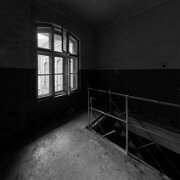
11 The power plant in Anina, Romania, known as the Anina Thermal Power Plant (Termocentrala Anina), has its roots in the industrial expansion of the early 20th century, closely tied to the development of coal mining in the Banat region. Anina was a significant mining center due to its rich coal deposits, and the construction of the power plant was intended to capitalize on this local resource to generate electricity. Built in stages beginning in the 1950s, during Romania’s communist industrialization push, the plant used lignite coal extracted from nearby mines to produce energy for both local industry and the national grid. It became a symbol of the city’s economic importance and a key employer in the area.
However, the fall of communism in 1989 marked the beginning of the plant’s decline. The aging infrastructure, environmental concerns, and decreasing efficiency of coal-based energy led to its gradual decommissioning. As Romania began transitioning toward more sustainable energy sources and restructuring its industrial sector, Anina’s coal mines closed, and the power plant followed suit in the early 2000s. Today, the ruins of the Anina power plant and its iconic chimney stand as remnants of the town’s industrial past—a poignant reminder of a once-thriving energy hub that played a critical role in the region’s development.
However, the fall of communism in 1989 marked the beginning of the plant’s decline. The aging infrastructure, environmental concerns, and decreasing efficiency of coal-based energy led to its gradual decommissioning. As Romania began transitioning toward more sustainable energy sources and restructuring its industrial sector, Anina’s coal mines closed, and the power plant followed suit in the early 2000s. Today, the ruins of the Anina power plant and its iconic chimney stand as remnants of the town’s industrial past—a poignant reminder of a once-thriving energy hub that played a critical role in the region’s development.
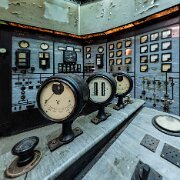
12 The power plant in Anina, Romania, known as the Anina Thermal Power Plant (Termocentrala Anina), has its roots in the industrial expansion of the early 20th century, closely tied to the development of coal mining in the Banat region. Anina was a significant mining center due to its rich coal deposits, and the construction of the power plant was intended to capitalize on this local resource to generate electricity. Built in stages beginning in the 1950s, during Romania’s communist industrialization push, the plant used lignite coal extracted from nearby mines to produce energy for both local industry and the national grid. It became a symbol of the city’s economic importance and a key employer in the area.
However, the fall of communism in 1989 marked the beginning of the plant’s decline. The aging infrastructure, environmental concerns, and decreasing efficiency of coal-based energy led to its gradual decommissioning. As Romania began transitioning toward more sustainable energy sources and restructuring its industrial sector, Anina’s coal mines closed, and the power plant followed suit in the early 2000s. Today, the ruins of the Anina power plant and its iconic chimney stand as remnants of the town’s industrial past—a poignant reminder of a once-thriving energy hub that played a critical role in the region’s development.
However, the fall of communism in 1989 marked the beginning of the plant’s decline. The aging infrastructure, environmental concerns, and decreasing efficiency of coal-based energy led to its gradual decommissioning. As Romania began transitioning toward more sustainable energy sources and restructuring its industrial sector, Anina’s coal mines closed, and the power plant followed suit in the early 2000s. Today, the ruins of the Anina power plant and its iconic chimney stand as remnants of the town’s industrial past—a poignant reminder of a once-thriving energy hub that played a critical role in the region’s development.
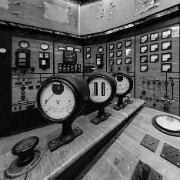
13 The power plant in Anina, Romania, known as the Anina Thermal Power Plant (Termocentrala Anina), has its roots in the industrial expansion of the early 20th century, closely tied to the development of coal mining in the Banat region. Anina was a significant mining center due to its rich coal deposits, and the construction of the power plant was intended to capitalize on this local resource to generate electricity. Built in stages beginning in the 1950s, during Romania’s communist industrialization push, the plant used lignite coal extracted from nearby mines to produce energy for both local industry and the national grid. It became a symbol of the city’s economic importance and a key employer in the area.
However, the fall of communism in 1989 marked the beginning of the plant’s decline. The aging infrastructure, environmental concerns, and decreasing efficiency of coal-based energy led to its gradual decommissioning. As Romania began transitioning toward more sustainable energy sources and restructuring its industrial sector, Anina’s coal mines closed, and the power plant followed suit in the early 2000s. Today, the ruins of the Anina power plant and its iconic chimney stand as remnants of the town’s industrial past—a poignant reminder of a once-thriving energy hub that played a critical role in the region’s development.
However, the fall of communism in 1989 marked the beginning of the plant’s decline. The aging infrastructure, environmental concerns, and decreasing efficiency of coal-based energy led to its gradual decommissioning. As Romania began transitioning toward more sustainable energy sources and restructuring its industrial sector, Anina’s coal mines closed, and the power plant followed suit in the early 2000s. Today, the ruins of the Anina power plant and its iconic chimney stand as remnants of the town’s industrial past—a poignant reminder of a once-thriving energy hub that played a critical role in the region’s development.
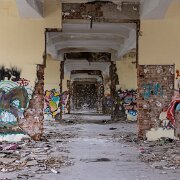
14 The Bragadiru Brewery, also known as "Fabrica de Bere Bragadiru," was established in the late 19th century by industrialist Dumitru Marinescu Bragadiru, one of Romania’s most prominent entrepreneurs of the time. Located on Calea Rahovei in Bucharest, the brewery was part of a larger industrial and cultural complex that included a beer hall, garden, and even a theater. Bragadiru envisioned not just a production facility but a landmark that would blend utility with elegance, drawing inspiration from Western European breweries. By the early 20th century, the Bragadiru Brewery had become one of the most important beer producers in Romania, known for its high-quality products and architectural beauty.
During the communist era, the brewery was nationalized and operated under state control, continuing to produce beer but gradually losing its original charm and prestige. After 1989, the property went through a period of decline and partial abandonment, like many other former industrial landmarks in Romania. In recent years, there has been renewed interest in restoring and repurposing the site. While brewing has ceased, the historic buildings have hosted cultural events, weddings, and art exhibitions, helping to preserve the memory of one of Bucharest’s iconic industrial heritage sites.
During the communist era, the brewery was nationalized and operated under state control, continuing to produce beer but gradually losing its original charm and prestige. After 1989, the property went through a period of decline and partial abandonment, like many other former industrial landmarks in Romania. In recent years, there has been renewed interest in restoring and repurposing the site. While brewing has ceased, the historic buildings have hosted cultural events, weddings, and art exhibitions, helping to preserve the memory of one of Bucharest’s iconic industrial heritage sites.
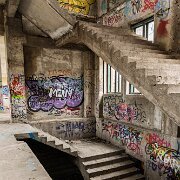
15 The Bragadiru Brewery, also known as "Fabrica de Bere Bragadiru," was established in the late 19th century by industrialist Dumitru Marinescu Bragadiru, one of Romania’s most prominent entrepreneurs of the time. Located on Calea Rahovei in Bucharest, the brewery was part of a larger industrial and cultural complex that included a beer hall, garden, and even a theater. Bragadiru envisioned not just a production facility but a landmark that would blend utility with elegance, drawing inspiration from Western European breweries. By the early 20th century, the Bragadiru Brewery had become one of the most important beer producers in Romania, known for its high-quality products and architectural beauty.
During the communist era, the brewery was nationalized and operated under state control, continuing to produce beer but gradually losing its original charm and prestige. After 1989, the property went through a period of decline and partial abandonment, like many other former industrial landmarks in Romania. In recent years, there has been renewed interest in restoring and repurposing the site. While brewing has ceased, the historic buildings have hosted cultural events, weddings, and art exhibitions, helping to preserve the memory of one of Bucharest’s iconic industrial heritage sites.
During the communist era, the brewery was nationalized and operated under state control, continuing to produce beer but gradually losing its original charm and prestige. After 1989, the property went through a period of decline and partial abandonment, like many other former industrial landmarks in Romania. In recent years, there has been renewed interest in restoring and repurposing the site. While brewing has ceased, the historic buildings have hosted cultural events, weddings, and art exhibitions, helping to preserve the memory of one of Bucharest’s iconic industrial heritage sites.

16 The Bragadiru Brewery, also known as "Fabrica de Bere Bragadiru," was established in the late 19th century by industrialist Dumitru Marinescu Bragadiru, one of Romania’s most prominent entrepreneurs of the time. Located on Calea Rahovei in Bucharest, the brewery was part of a larger industrial and cultural complex that included a beer hall, garden, and even a theater. Bragadiru envisioned not just a production facility but a landmark that would blend utility with elegance, drawing inspiration from Western European breweries. By the early 20th century, the Bragadiru Brewery had become one of the most important beer producers in Romania, known for its high-quality products and architectural beauty.
During the communist era, the brewery was nationalized and operated under state control, continuing to produce beer but gradually losing its original charm and prestige. After 1989, the property went through a period of decline and partial abandonment, like many other former industrial landmarks in Romania. In recent years, there has been renewed interest in restoring and repurposing the site. While brewing has ceased, the historic buildings have hosted cultural events, weddings, and art exhibitions, helping to preserve the memory of one of Bucharest’s iconic industrial heritage sites.
During the communist era, the brewery was nationalized and operated under state control, continuing to produce beer but gradually losing its original charm and prestige. After 1989, the property went through a period of decline and partial abandonment, like many other former industrial landmarks in Romania. In recent years, there has been renewed interest in restoring and repurposing the site. While brewing has ceased, the historic buildings have hosted cultural events, weddings, and art exhibitions, helping to preserve the memory of one of Bucharest’s iconic industrial heritage sites.

17 The Bragadiru Brewery, also known as "Fabrica de Bere Bragadiru," was established in the late 19th century by industrialist Dumitru Marinescu Bragadiru, one of Romania’s most prominent entrepreneurs of the time. Located on Calea Rahovei in Bucharest, the brewery was part of a larger industrial and cultural complex that included a beer hall, garden, and even a theater. Bragadiru envisioned not just a production facility but a landmark that would blend utility with elegance, drawing inspiration from Western European breweries. By the early 20th century, the Bragadiru Brewery had become one of the most important beer producers in Romania, known for its high-quality products and architectural beauty.
During the communist era, the brewery was nationalized and operated under state control, continuing to produce beer but gradually losing its original charm and prestige. After 1989, the property went through a period of decline and partial abandonment, like many other former industrial landmarks in Romania. In recent years, there has been renewed interest in restoring and repurposing the site. While brewing has ceased, the historic buildings have hosted cultural events, weddings, and art exhibitions, helping to preserve the memory of one of Bucharest’s iconic industrial heritage sites.
During the communist era, the brewery was nationalized and operated under state control, continuing to produce beer but gradually losing its original charm and prestige. After 1989, the property went through a period of decline and partial abandonment, like many other former industrial landmarks in Romania. In recent years, there has been renewed interest in restoring and repurposing the site. While brewing has ceased, the historic buildings have hosted cultural events, weddings, and art exhibitions, helping to preserve the memory of one of Bucharest’s iconic industrial heritage sites.
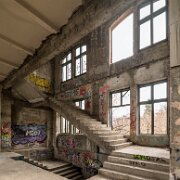
18 The Bragadiru Brewery, also known as "Fabrica de Bere Bragadiru," was established in the late 19th century by industrialist Dumitru Marinescu Bragadiru, one of Romania’s most prominent entrepreneurs of the time. Located on Calea Rahovei in Bucharest, the brewery was part of a larger industrial and cultural complex that included a beer hall, garden, and even a theater. Bragadiru envisioned not just a production facility but a landmark that would blend utility with elegance, drawing inspiration from Western European breweries. By the early 20th century, the Bragadiru Brewery had become one of the most important beer producers in Romania, known for its high-quality products and architectural beauty.
During the communist era, the brewery was nationalized and operated under state control, continuing to produce beer but gradually losing its original charm and prestige. After 1989, the property went through a period of decline and partial abandonment, like many other former industrial landmarks in Romania. In recent years, there has been renewed interest in restoring and repurposing the site. While brewing has ceased, the historic buildings have hosted cultural events, weddings, and art exhibitions, helping to preserve the memory of one of Bucharest’s iconic industrial heritage sites.
During the communist era, the brewery was nationalized and operated under state control, continuing to produce beer but gradually losing its original charm and prestige. After 1989, the property went through a period of decline and partial abandonment, like many other former industrial landmarks in Romania. In recent years, there has been renewed interest in restoring and repurposing the site. While brewing has ceased, the historic buildings have hosted cultural events, weddings, and art exhibitions, helping to preserve the memory of one of Bucharest’s iconic industrial heritage sites.
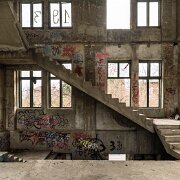
19 The Bragadiru Brewery, also known as "Fabrica de Bere Bragadiru," was established in the late 19th century by industrialist Dumitru Marinescu Bragadiru, one of Romania’s most prominent entrepreneurs of the time. Located on Calea Rahovei in Bucharest, the brewery was part of a larger industrial and cultural complex that included a beer hall, garden, and even a theater. Bragadiru envisioned not just a production facility but a landmark that would blend utility with elegance, drawing inspiration from Western European breweries. By the early 20th century, the Bragadiru Brewery had become one of the most important beer producers in Romania, known for its high-quality products and architectural beauty.
During the communist era, the brewery was nationalized and operated under state control, continuing to produce beer but gradually losing its original charm and prestige. After 1989, the property went through a period of decline and partial abandonment, like many other former industrial landmarks in Romania. In recent years, there has been renewed interest in restoring and repurposing the site. While brewing has ceased, the historic buildings have hosted cultural events, weddings, and art exhibitions, helping to preserve the memory of one of Bucharest’s iconic industrial heritage sites.
During the communist era, the brewery was nationalized and operated under state control, continuing to produce beer but gradually losing its original charm and prestige. After 1989, the property went through a period of decline and partial abandonment, like many other former industrial landmarks in Romania. In recent years, there has been renewed interest in restoring and repurposing the site. While brewing has ceased, the historic buildings have hosted cultural events, weddings, and art exhibitions, helping to preserve the memory of one of Bucharest’s iconic industrial heritage sites.

20 The Bragadiru Brewery, also known as "Fabrica de Bere Bragadiru," was established in the late 19th century by industrialist Dumitru Marinescu Bragadiru, one of Romania’s most prominent entrepreneurs of the time. Located on Calea Rahovei in Bucharest, the brewery was part of a larger industrial and cultural complex that included a beer hall, garden, and even a theater. Bragadiru envisioned not just a production facility but a landmark that would blend utility with elegance, drawing inspiration from Western European breweries. By the early 20th century, the Bragadiru Brewery had become one of the most important beer producers in Romania, known for its high-quality products and architectural beauty.
During the communist era, the brewery was nationalized and operated under state control, continuing to produce beer but gradually losing its original charm and prestige. After 1989, the property went through a period of decline and partial abandonment, like many other former industrial landmarks in Romania. In recent years, there has been renewed interest in restoring and repurposing the site. While brewing has ceased, the historic buildings have hosted cultural events, weddings, and art exhibitions, helping to preserve the memory of one of Bucharest’s iconic industrial heritage sites.
During the communist era, the brewery was nationalized and operated under state control, continuing to produce beer but gradually losing its original charm and prestige. After 1989, the property went through a period of decline and partial abandonment, like many other former industrial landmarks in Romania. In recent years, there has been renewed interest in restoring and repurposing the site. While brewing has ceased, the historic buildings have hosted cultural events, weddings, and art exhibitions, helping to preserve the memory of one of Bucharest’s iconic industrial heritage sites.
Urbex